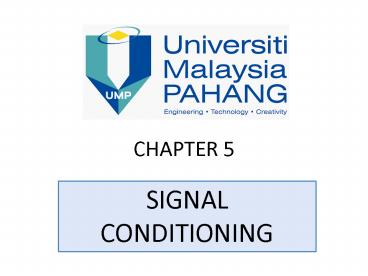SIGNAL CONDITIONING - PowerPoint PPT Presentation
1 / 18
Title:
SIGNAL CONDITIONING
Description:
The internal resistance of galvanometer, Rg = 100O. (i) Calculate the value of ... (ii) Determine the deflection of galvanometer if its sensitivity is 1mm/ A. ... – PowerPoint PPT presentation
Number of Views:76
Avg rating:3.0/5.0
Title: SIGNAL CONDITIONING
1
CHAPTER 5
- SIGNAL CONDITIONING
2
Structure For Chapter 5
- INTRODUCTION TO SIGNAL CONDITIONING
- BRIDGE WHEATSTONE BRIDGE
- Balanced Condition
- Unbalanced Condition
- AMPLIFIER
- PROTECTION
- FILTERS Low Pass, High Pass Band Pass
3
Introduction
- Signal conditioning refers to operations
performed on signals to convert them to a form
suitable for interfacing with other elements in
the process-control loop. - The signal may be
4
Bridge
- Definition Bridges are electrical circuits for
performing null measurements on resistances in DC
and general impedances in AC. - Bridge circuit are used to convert impedance
variations into voltage variations.
5
Wheatstone Bridge
- DC Bridge (Wheatstone Bridge)
- Two conditions to be considered
- Balance Condition
- Ig 0
- Unbalance Condition
- Ig ? 0
6
Balance condition, Ig 0
- The current through the galvanometer, Ig 0
7
Derivation
Vcb Vdb ? I3R3 I4R4 Vca Vda ? I1R1 I2R2
Therefore,
I1 I3 I2 I4
Using voltage divider,
If R4 is unknown resistor
8
Derivation
Apply KCL at node C I1-I3-Ig 0, since Ig0,
I1I3 Apply KCL at node D I2-I4Ig 0, since Ig
0, I2I4
Vcb Vdb ? I3R3 I4R4 Vca Vda ? I1R1 I2R2
(I4R4)/(I2R2) (I3R3)/I1R1 ? Solve for R4
9
Unbalance condition, Ig ? 0
- The current flowing through the galvanometer, Ig.
- Ig is determined using a Thevenin eq. circuit.
c
d
10
Derivation
Vth Vcd VR1 VR2 or
VR4 VR3
VR1, VR2, VR3, VR4 Voltage divider
11
Derivation (contd)
Apply KVL in the RED loop Vth -VR2VR1VR1-VR2
-
-
Apply KVL in the BLUE loop Vth VR4-VR3
-
-
12
Derivation (contd)
OR
13
Derivation Sensitivity (contd)
Rg, the internal resistance of the galvanometer
is neglected
If a load is connected across the output terminal
Zth
Total deflection of galvanometer
D S Ig
S sensitivity of the galvanometer
14
Derivation (contd)
Zth
15
Example 1
If a Wheatstone bridge, as shown in Figure 2,
nulls with R11000O, R2842O, and R3500 O, find
the value of R4
16
Example 2
- The resistors in a bridge are given by
R1R2R3120O and R4121O. If the supply is 10.0
V, find the voltage offset.
17
Example 3
The Wheatstone bridge circuit as in Figure 3 is
unbalanced when R130kO, R210kO, R3 2kO, R4
5kO and E 5V. The internal resistance of
galvanometer, Rg 100O. (i) Calculate the
value of Ig that will flow through the
galvanometer. (ii) Determine the deflection
of galvanometer if its sensitivity is 1mm/µA.
(iii) If R4 is replaced with a new Rx, obtain
the value of Rx when the bridge is balance.
18
Example 4
At 20oC, the Wheatstone bridge as shown in Figure
4 is in balance condition when R11000O, R2842O,
and R3500 O. Meanwhile, R4 is copper Resistance
Temperature Detector (RTD).The internal
resistance of galvanometer, Rg100O and the
temperature coefficient of the RTD, a0.0042O/oC.
If the RTD is dipped into boiling water (100oC),
determine the deflection of galvanometer if its
sensitivity is 1mm/µA































